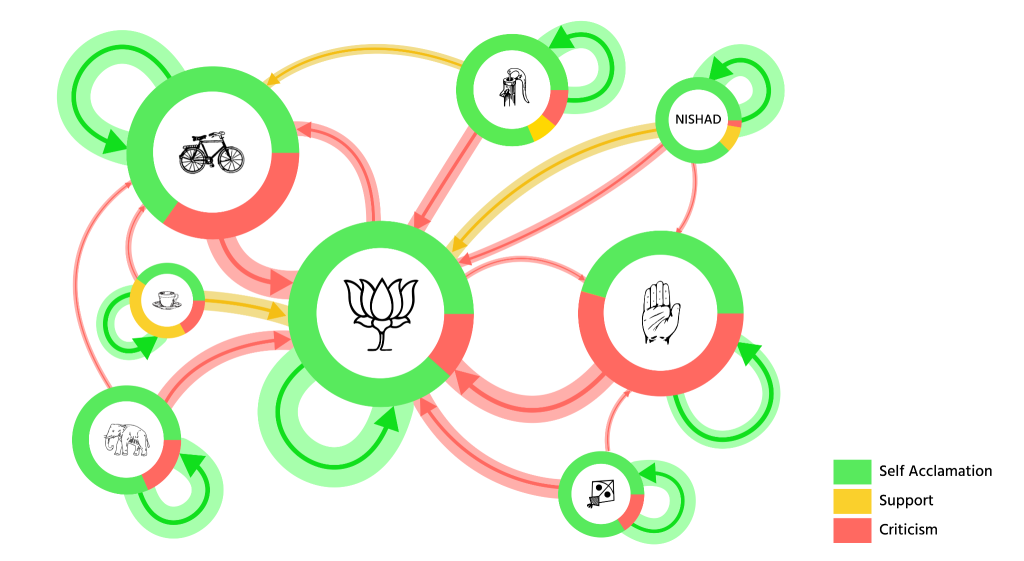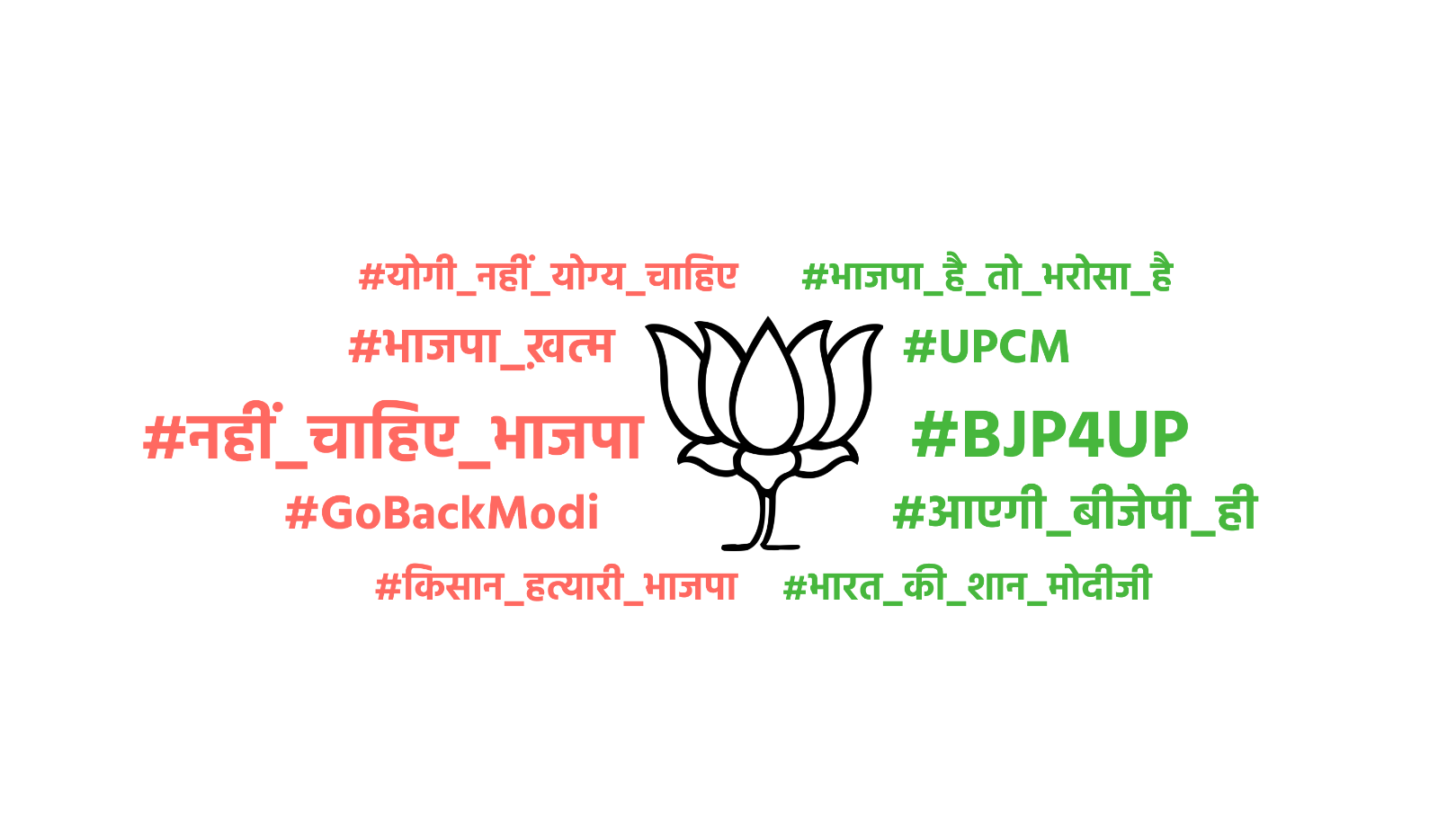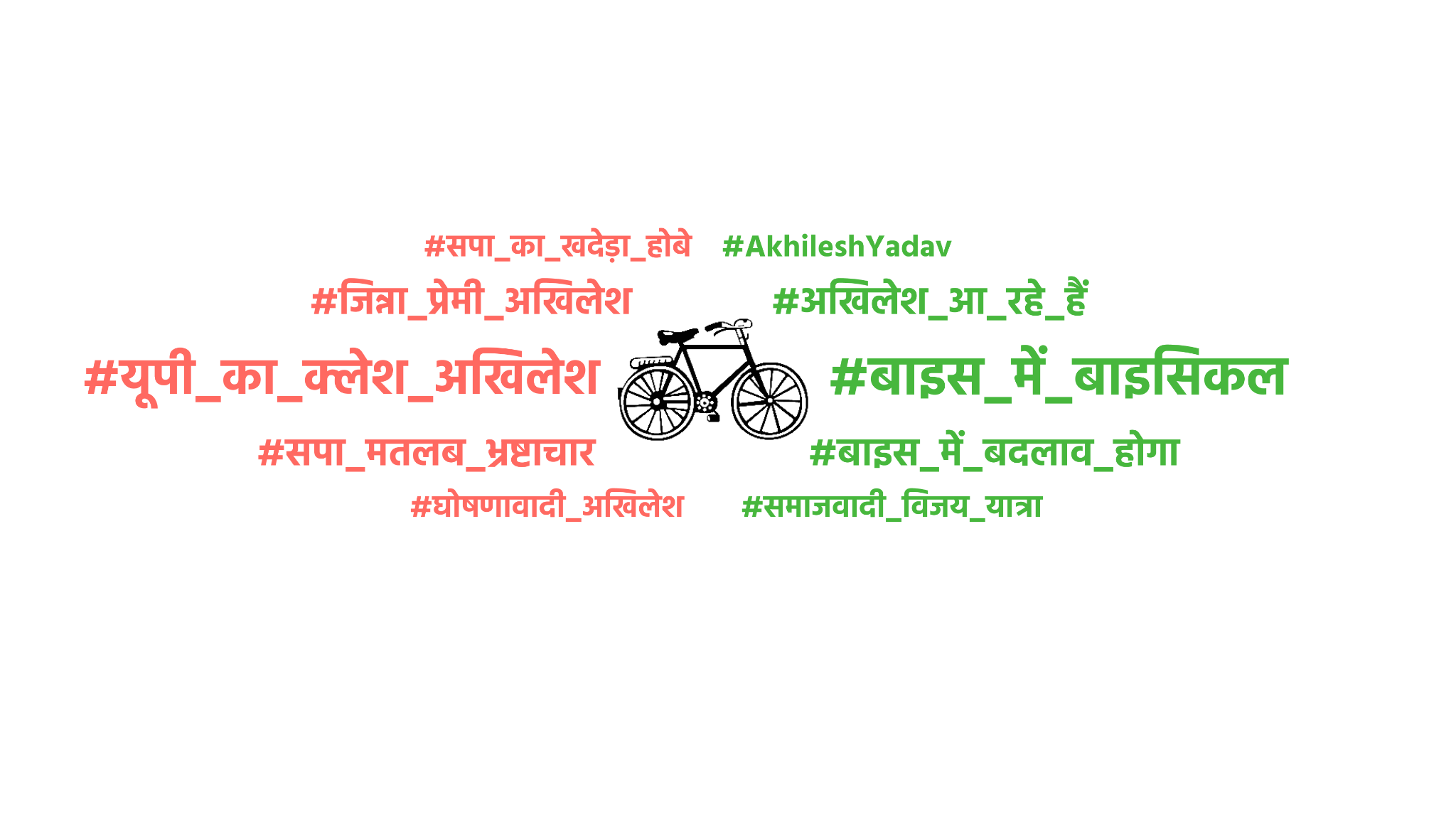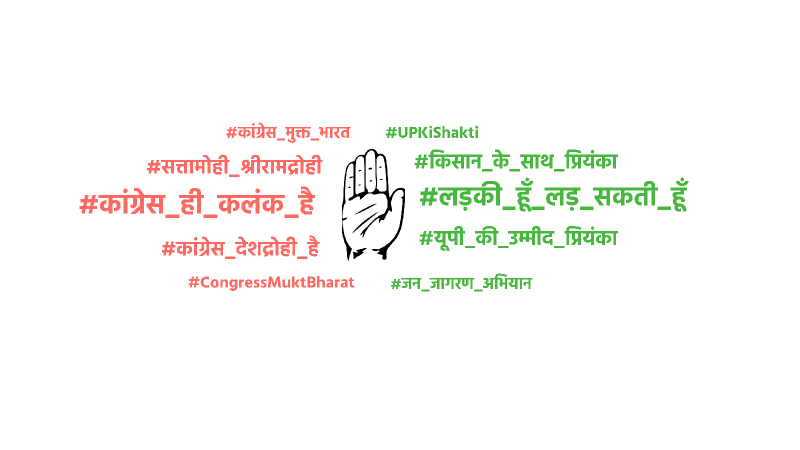What #hashtag wars tell us about the organization of Uttar Pradesh IT cells, and how parties mark their allies and enemies
Pitched battles on Twitter are increasingly common among the key players in the Uttar Pradesh elections, since the praises, innuendo, and insults that take shape and virality on Twitter often find new lives on other social media such as WhatsApp, but also on mainstream television and web-based news. We studied nine parties contesting the state legislative elections in Uttar Pradesh – BJP, SP, INC, RLD, BSP, AIMIM, Nishad Party, AAP, and Apna Dal, and collected the hashtags used by over 11,000 politicians at various levels, from sitting MPs and MLAs to party workers. We collected all the hashtags used by the said politicians during Sep 2021 to Jan 2022.
We sorted them based on the frequency of their usage, and listed the top 10 hashtags for each week, hand-coded each of them for the textual content.We see three forms of critical hashtags — first, a character assassination, typically aimed at an individual politician (such as namecalling the Gandhi family by referring to Jawaharlal Nehru as a womanizer through hashtags like #ठरकी_दिवस,), second a criticism of a party’s ideology or casting of an entire party under a specific form of name-calling (such as questioning the patriotism of Samajwadi party through hashtags like #जिन्ना_प्रेमी_अखिलेश), and third, an attack on some action attributable to the party (such as blaming unemployment or the farming crisis on on BJP’s policies through hashtags like #किसान_हत्यारी_भाजपा). We also find two broad directions of attribution in the hashtags. The first is a hashtag construction that attempts to show one’s own leader or party in a positive light – which can we refer to as self-acclaim, or claims that one’s party is going to win, and the second is antagonistic or critical hashtags that attempt to show one’s opposition negatively. We visualize a third category here, of support, which suggests hashtags that are supportive of a third party, usually an alliance party.

In figure 1, a graph with directed edges, each node is a party (represented by the logo within the node). Size of the node is proportional to the number of politicians present in our dataset from that party. The edges show the hashtag interaction between the parties. The colour of the edge shows the tenor of the hashtag, the direction of the edge is shown by the arrowhead, and the intensity of interaction is represented by the thickness of the edge. For instance, if we see the outgoing edges from AIMIM, we see that AIMIM used a lot more criticising hashtags aimed at BJP more than towards Congress.
The self-edges (loops starting and ending at the same node) show how much self-promoting hashtags a party uses. For instance, we can observe that Congress and Apna Dal engage less in self-promotion than the other parties, as shown by the thickness of the self-edges. The pie-chart around each party’s logo shows the distribution of polarity in all the hashtags used by that party. For instance, we can see that Congress engages more in criticising others than self-promotion, whereas parties like Nishad and RLD hardly use criticising hashtags.
We see two important trends from the graph above (and full data linked below). First, despite the relatively large lead that the BJP has over the other parties in terms of its total representation of accounts on Twitter – almost all the parties are fairly aggressive in using hashtags as a means of getting their base. We see that the BJP mainly speaks positively about itself and its achievements in hashtags, using them sparingly for attack. When it does use hashtags to attack, the main target is SP, with a small number of anti-INC hashtags. With the Samajwadi Party, we see that the attack is almost squarely aimed at BJP. The party also has a much higher share of negative hashtags compared to the BJP. The INC, on the other hand, is the only party with more negative hashtags aimed at another party (in its case, entirely aimed at BJP). The BSP mostly has positive hashtags about its own party, and has a small number of attack hashtags aimed at all three other major parties – BJP, SP, and INC.
There are two interesting trends with the smaller parties. First, we see a consistent trend with the alliance partner parties, in that while they engage the larger partner in their hashtags, the larger partner does not engage them back. Thus, RLD has hashtags about its partner SP (and attack hashtags aimed at BJP) whereas SP does not reciprocate. Similarly, both Nishad Party and Apna Dal shout out to the BJP in their messaging, with no reciprocity offered. Interestingly, a lot of Nishad Party’s hashtags and messaging prior to the alliance being formalized was around reservations, and underlining that it would encourage supporters to vote against BJP if its demands were not followed through.
A lot of the behaviour we see around centralized hashtagging that signals support aligns with the broader patterns of electoral alliances, which are often driven by leaders and the exigencies of vote bank politics, but often not reciprocated at the level of field workers. Hashtags are driven by the IT cells of parties rather than by the politicians themselves, suggesting that they do not show the same engagement back.
Party Hashtags
BJP
First we see one important distinction between the hashtag use of the BJP and that of its allied party. BJP politicians tend to tweet about Yogi in hashtags (eg YogiWillBeBack, UPyogiHaiYogi), but their allied parties like Apna Dal and Nishad Party use hashtags centered on Modi. This suggests that the allies distance see Modi as more saleable to their parties than Yogi, who comes with both caste and incumbency baggage. Allies’ most used tags referring to the BJP were BravePMModi, BharatStandsWithModiJi, ModiJiJiyoHazaroSaal. We also see that the more aggressively toned hashtags, such as those claiming that the SP is a Muslim-preference party, tend to be constructed in Hindi. Figure 2 shows the most used hashtags in support of and in opposition to BJP.

SP
The politicians from SP were very organised in tweeting and the usage of hashtags every week. There were relatively fewer unique hashtags when compared to other parties, and the same set of hashtags were largely used every week, in order to trend and maximise the reach of the hashtags. In particular, they coalesced around “बाइस_में_बाइसिकल” which was the most widely used hashtag, and for which they were able to frequently get Twitter trending status, suggesting that they had mastered getting around the Twitter algorithm. We also see that the hashtag-based attacks on SP are mainly driven by attacking Akhilesh directly – which could leave the door open for politicians in the party who choose to switch over in the event of a hung assembly.

INC
Priyanka Gandhi being the face of the party in UP was portrayed clearly through the top self-promoting hashtags, and the party’s main hashtag, “लड़की_हूँ_लड़_सकती_हूँ” was consistently highlighted by party workers. Unlike SP which largely attacks Yogi, INC attacks the party and its two leaders, Yogi and Modi through its use of hashtags. In fact, we see that even though the key hashtag is focused on women, over 80% of the politicians using the # लड़की_हूँ_लड़_सकती_हूँ hashtag are male.

Appendix 1: Data on hashtag spread and direction
| Bjp | Sp | inc | rld | bsp | aimim | Nishad | aap | apna dal | |
| Bjp | 110 + | 11 – | 3 – | 0 | 0 | 0 | 0 | 1 – | |
| sp | 49 – | 92 + | |||||||
| inc | 53 – | 49 + | |||||||
| rld | 14 – | 5 + | 108 + | ||||||
| bsp | 10 – | 2 – | 3 – | 106+ | |||||
| aimim | 13 – | 2 – | 82 + | ||||||
| nishad | 7 – followed by 11 + | 2 – | 94 + | 1 – | |||||
| aap | 21 – | 64 + | |||||||
| apna dal | 16+ | 3 – | 1 – | 1 – | 1 – | 15+ |
This research is being carried out by:
Asmit Singh*, Jivitesh Jain*, Lalitha Kameswari*, Ponnurangam Kumaraguru, Joyojeet Pal
*Asmit Singh , Jivitesh Jain and Lalitha Kameswari contributed equally to the research and writing of this report.
This report can also be accessed on Prof. Joyojeet Pal’s blog.